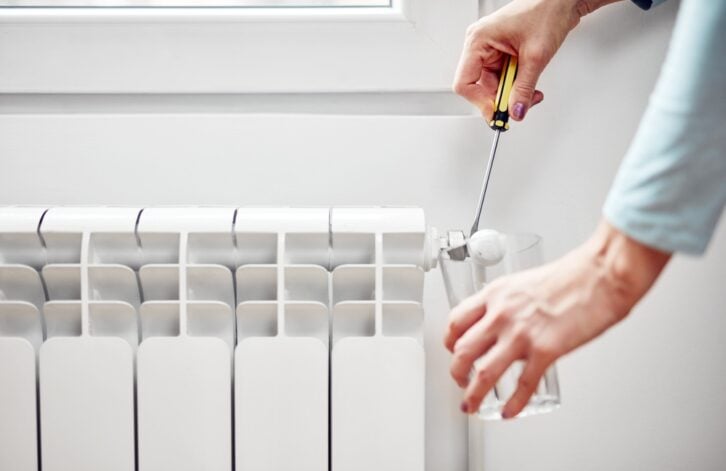Radiators are one of the essential elements of your home’s heating system, and it’s important to make sure they operate at peak efficiency in order to maintain a warm and comfortable living environment, especially during the colder months. However, many homeowners unknowingly have radiators that are underperforming. This can lead to higher energy bills and a less effective heating system.
The good news is that with a few simple and often low-cost adjustments, you can significantly improve your radiators’ efficiency. This comprehensive guide by heating expert Thomas Halpin at PriceYourJob.co.uk will delve into a range of practical tips and tricks, helping you to transform your heating system from a costly necessity to a powerful and effective heat source.
The Problem with Inefficient Radiators
Before delving into the solutions, it’s important to understand the common issues that come with inefficient radiators. The primary goal of a radiator is to transfer thermal energy from the hot water circulating within it to the surrounding air. This heat transfer occurs through a combination of radiation and convection. Radiation is the direct transfer of heat, while convection involves the movement of air as it warms up and circulates.
When a radiator is not working properly, the above processes are hindered. Some of the most common problems include:
- Trapped Air: Air can make its way into your heating system and accumulate at the top of a radiator. This prevents the hot water from circulating properly and can then lead to cold spots on the radiator. This means that not all of the radiator’s surface area is being used to heat the room.
- Heat Loss: Radiators mounted on external walls can lose a significant amount of heat through the wall itself. This is particularly prevalent in older homes with poor insulation. Instead of warming the room, the heat is simply escaping outdoors.
- Blocked Convection: Dirt, dust, and even household items can obstruct the flow of air around and through the radiator. This prevents the warm air from circulating freely and stops it from warming the room evenly.
- Incorrect Sizing or Placement: A radiator that is too small for the room will have to work overtime to reach the desired temperature. A poorly placed radiator will struggle to heat the room properly.
By addressing the above issues, you can not only make your home warmer but also reduce the strain on your boiler, potentially extending its lifespan and lowering your energy consumption.
The Basics: Bleeding and Cleaning
Bleeding your radiators is one of the most effective ways to improve their performance. This process involves releasing any trapped air from the system. Air is a poor conductor of heat and can form pockets inside the radiator, preventing hot water from filling the entire unit.
To prepare for bleeding a radiator, ensure that your heating is turned off. You should also have an old rag on hand to catch any spraying or dripping water that may come out when you turn the radiator key.
- Run your hand over the radiator to check if it is cold at the top or bottom. If it is cold at the top, that means there is air trapped in the radiator, and it needs to be bled
- Begin by turning off your central heating
- Next, place an old rag underneath the valve to catch any water that may drip out during the bleeding process.
- Use the radiator key and turn it anti-clockwise about a quarter of a turn until the air stops and the water runs smoothly out of the valve
- Then, turn the valve off again.
- You can then turn your heating system back on, and the problem should be solved.
Dust and dirt can heavily affect a radiator’s performance. Over time, a layer of dust can accumulate on and within the radiator fins. This dust acts as an insulator, creating a barrier that prevents the efficient transfer of heat from the radiator to the air. Cleaning the entire radiator, including the space between the fins, can significantly improve its heat output.
How to Clean a Radiator Properly
Follow these steps to clean your radiator in a simple but effective way:
- Turn off the central heating and make sure the radiators are cold before you start cleaning. A hot radiator is difficult to clean effectively, and you could burn yourself.
- Place a heavy-duty dust sheet on the floor beneath the radiator to collect debris and keep the floor clean and dry.
- Fit the small brush attachment to your vacuum cleaner and use it to remove the dust, cobwebs and debris from the radiator. Pay particular attention to the back of the radiator, closest to the wall, where dust and cobwebs accumulate. Use a long-handled duster or brush for difficult-to-reach places
- The convector fins on the radiator are also dust traps, so you will need close attention with your vacuum cleaner. Alternatively, use a hairdryer to blow dust and cobwebs out of the radiator’s convector fins and then hoover up the debris. Compressed air also works, or you could invest in a radiator brush, which is like a long, flexible bottle brush.
- Create a solution of mild detergent, warm water and some white vinegar in a bucket or bowl.
- Using a soft cloth or sponge, dip it in the solution and wring it out until it’s slightly damp. Then wipe down all surfaces of the radiator, concentrating on any obvious marks, stains or finger marks. Don’t use an abrasive sponge, as this can scratch the surface of the radiator.
- Use a separate cloth and some clean water to remove any soapy residue from the radiator and then leave it to dry or wipe down with a dry cloth.
Smart Placement and Insulation
Where your radiators are located and how they interact with their surroundings play a huge role in their effectiveness. By optimising their placement and adding simple insulation, you can prevent a significant amount of heat from being wasted.
Invest in Radiator Reflectors
Radiator reflectors are relatively cheap and easy to install. They are fitted behind the radiator and help to ensure that heat isn’t wasted by passing through the wall behind the radiator. Instead, these handy devices ensure that as much heat as possible is reflected back into the room.
How to Install Radiator Reflectors
- Measure the area behind your radiator and cut the reflector panel to size.
- The panels are usually lightweight and can be easily attached to the wall with adhesive pads or double-sided tape.
- Ensure the reflective side is facing the radiator.
Place a Shelf Above the Radiator
A shelf above the radiator can help to reflect the heat back out into the room. It can also prevent heat from rising and becoming trapped in the ceiling. Instead, the warm air will be pushed out into the room. Shelves above the radiator are especially useful when combined with reflectors.
Tips for Using a Radiator Shelf
- Material: Opt for a material that won’t warp or be damaged by heat, such as wood or MDF.
- Placement: Ensure the shelf is not too close to the radiator, allowing for some airflow. A gap of at least 3-4 inches is recommended.
- Combined Effect: A shelf above the radiator is especially useful when combined with reflectors. The reflector pushes heat forward, and the shelf directs the rising warm air outward, creating a double-action efficiency boost.
Strategic Habits and System Optimisation
Beyond the physical modifications listed above, some changes in daily habits and a deeper understanding of your heating system can also lead to significant energy gains.
Don’t Cover Your Radiators
While it may be tempting to use a radiator as a place to dry laundry or as a spot for furniture, doing this will drastically reduce its efficiency. Covering a radiator with wet clothes, for example, creates a barrier that traps the heat, forcing the boiler to work harder to maintain the room’s temperature. Similarly, placing large pieces of furniture like sofas or cabinets directly in front of a radiator will block the convection process, and this will prevent warm air from circulating freely.
Make sure there is a clear space of at least a foot in front of and around your radiators. If you need to dry your laundry indoors, use a clothes horse or a separate drying rack. The minimal cost of a drying rack is far outweighed by the long-term savings on your energy bills.
Utilise Your Thermostatic Radiator Valves (TRVs)
Thermostatic Radiator Valves are a fantastic tool for zone-based heating. Instead of turning on every radiator to full blast, TRVs allow you to set the desired temperature for individual rooms. This means you can keep the radiators on a low setting in rooms you don’t use often, such as guest bedrooms, and turn up the heat in living areas or bedrooms as needed. This prevents you from wasting energy heating parts of your home that are not in use.
The Benefits of TRVs
- Substantial Energy Savings and Lower Costs: By enabling these room-specific temperature controls, TRVs can help contribute to a significant reduction in your home’s energy consumption and associated heating costs, directly impacting household budgets.
- Enhanced Thermal Comfort: The ability to create these personalised temperature zones enhances the homeowner’s and home user’s comfort and satisfaction, ensuring that each room is maintained at a comfortable temperature, catering to individual preferences.
- Measurable Environmental Sustainability and Carbon Footprint Reduction: Lower energy consumption translates to a reduced carbon footprint, contributing to environmental sustainability and aligning with national efforts to mitigate climate change.
- Precise Temperature Regulation and Control for Maximised Efficiency: TRVs can provide a high degree of precision when it comes to temperature regulation. This allows for fine-tuned control over individual room temperatures, maximising heating efficiency and also minimising waste.
Final Thoughts
Making your radiators work more efficiently is not a big task that requires a professional. By following some simple and effective strategies, you can transform your home’s heating system. From simple bleeding and cleaning to the smart use of reflectors and shelves, each tip contributes to a more effective and less wasteful operation. The key takeaway is that an efficient heating system is a combination of proper maintenance, thoughtful placement, and smart usage. By implementing these tips, you will not only enjoy a warmer, more comfortable home but also reap the financial benefits of lower energy bills and a heating system that performs at its very best.






